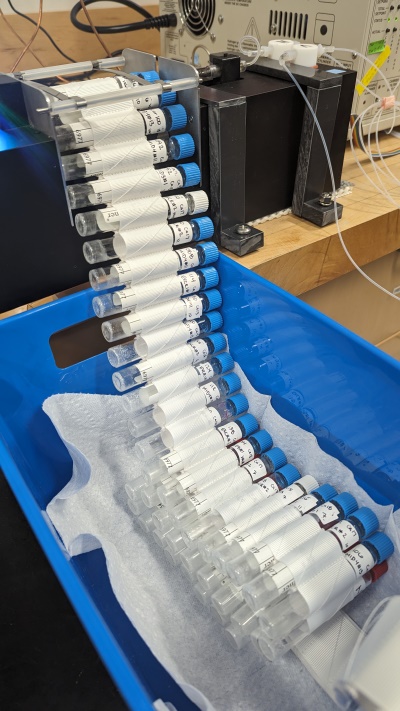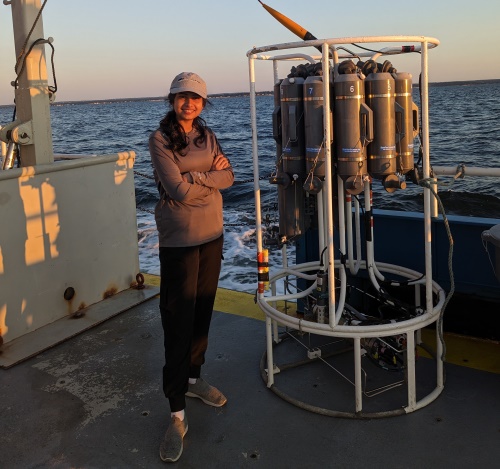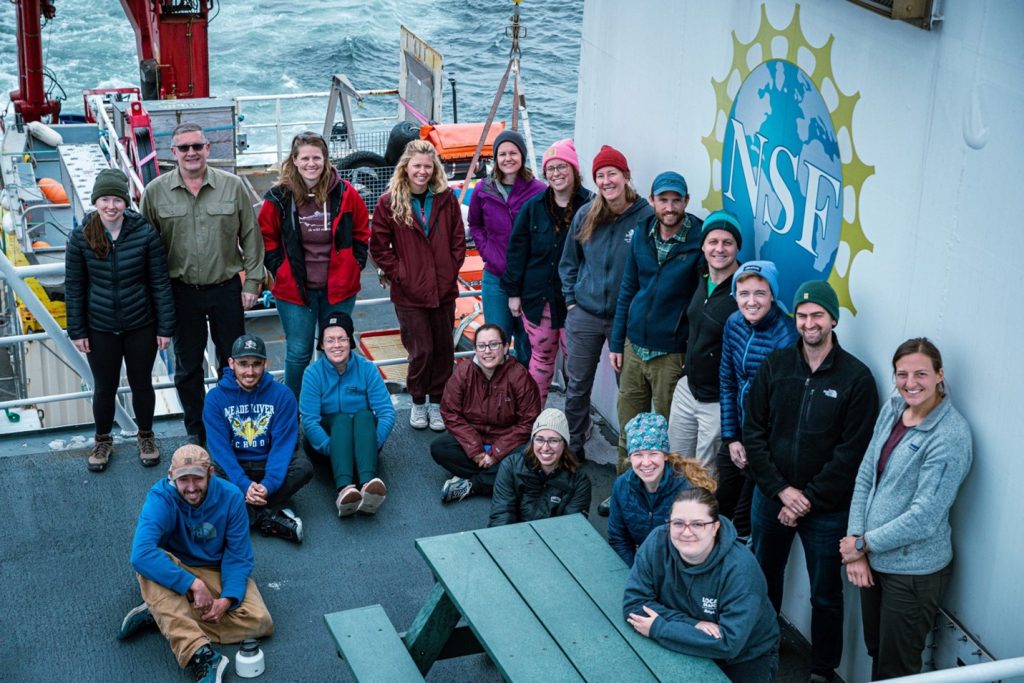News
Follow us on Instagram (@uconn.gbl) for the latest news, music videos and photos from our group!
December 2024 – We have a new grant funded (with co-PIs Leonel Romero and Samantha Siedlecki)! Our proposal “Improved mechanistic understanding of hypoxia drivers in western Long Island Sound enabled with data from a wire-following profiler and coupled biogeochemical-hydrodynamic modeling” was funded by the Long Island Sound Study Research Grant program. Apply to be a postdoc working on this project!
April/May 2024 – Cara presents data generated in our lab for the very first time at the Long Island Sound Research Conference! Kelsey and Anagha do another cruise in Long Island Sound.
New paper published in Frontiers in Marine Science: “A model for community-driven development of best practices: the Ocean Observatories Initiative Biogeochemical Sensor Data Best Practices and User Guide” by Palevsky et al. (2024)
February/March 2024 – Anagha passes her general exam, Cara presents at the 2024 Ocean Sciences Meeting, Kelsey and Anagha present at the Sip ‘N Science outreach event, and a new mass spectrometer arrives for Kelsey’s PhD research!

January 2024 – Cara starts teaching Introduction to Oceanography with a class playlist (two songs per class that are thematically related to the lecture). Check out the playlist on the left or check it out on Spotify!
October 2023 – Another cruise on the R/V Connecticut! And, we start analyzing all the samples we collected in 2023!

August 2023 – Cara and Anagha participate in their first cruise on the R/V Connecticut in Long Island Sound. They collected continuous surface measurements of oxygen and nitrogen gas, and bottle samples for methane and nitrous oxide. Thanks to the Tobias group for letting us come along!
Also, Kelsey joins the research group!

August 2023 – Cara’s first federal grant as lead PI is awarded! The proposal is titled “Unlocking the noble gas toolbox to quantify rates of denitrification and nitrogen fixation in marine systems” and will involve the application of noble gas measurements (Ne, Ar, and Kr) to improve quantification of nitrogen fixation and denitrification rates through sediment core incubations, mesocosm incubations, and in situ time-series. This approach will involve the development of a new technique for high-throughput noble gas (Ne, Ar, Kr) measurements. Our incoming PhD student Kelsey will be leading this work!
Photo on the right: Cara submitting the grant to NSF!

July 2023 – A report that Cara coauthored, “OOI Biogeochemical Sensors Data: Best Practices & User Guide” is now published and endorsed by the Global Ocean Observing System. Thanks to Hilary Palevsky and Sophie Clayton for their vision and leadership, and the US OCB team for supporting this work!
June 2023 – Cara participates in the Arctic Icebreaker Coordinating Committee (AICC) Early Career Chief Scientist Training Cruise in the Bering Sea on the R/V Sikuliaq! Below is a photo of all the science participants and mentors and on the right is a cruise video by Cara, from Instagram.


May 2023 – We are now federally funded through the NSF award “Exploring the dynamics of nitrous oxide in the Benguela Upwelling System.” The lab and especially our PhD student Anagha have an exciting three years ahead, collecting discrete and continuous measurements of nitrous oxide (N2O) in this under-studied upwelling system and quantifying air-sea fluxes in multiple seasons. The N2O dataset we collect will subsequently be integrated into machine learing models and used to predict regional-scale N2O distributions and fluxes from historical data and hydrographic model output. Read all about it on nsf.gov!
The figure on the left is from Flynn et al. (2020) and shows the locations where we plan to collect N2O samples.
April 2023 – New paper! Nitrous oxide (N2O), a powerful greenhouse gas, is an asymmetrical molecule with the structure NNO. Using isotope ratio mass spectrometry, researchers can separately quantify the N isotopic composition of the two N atoms within N2O. This is achieved by measuring the isotopic compostion of intact N2O as well as the NO fragment. However, reactions occurring within the mass spectrometer cause some of these NO fragments to become “scrambled” such that they contain an N atom that was actually in the terminal position. This paper describes an analytical protocol and software package for correcting N2O data from isotope ratio mass spectrometry for the scrambling effect, enabling reliable N2O isotopocule measurements.
Pyisotopomer: A Python package for obtaining intramolecular isotope ratio differences from mass spectrometric analysis of nitrous oxide isotopocules
Colette L. Kelly, Cara Manning, Claudia Frey, Jan Kaiser, Noah Gluschankoff, and Karen L. Casciotti (2023)
Rapid Communications in Mass Spectrometry


December 2022 – Anagha Payyambally receives the Quad Fellowship, a graduate fellowship operated by Schmidt Futures. Anagha is one of only 100 recipients out of 3200 applicants across all STEM fields to receive this award. Congratulations, Anagha! We are thrilled to see you receive this well-deserved honor!
The Quad Fellowship program “empowers exceptional engineering, mathematics, science, and technology graduate students to advance research and innovation with a lens of positive social impact throughout their careers by providing scholarships, immersive and inspiring events, mentorship and career-advancing programming, and cross-cultural exchange opportunities.” Read Anagha’s bio here!
August 2022 – Our first graduate student, Anagha, joins the group! Anagha previously completed a Bachelor’s degree in Chemistry at Kannur University and a Master’s degree in Hydrochemistry at the Cochin University of Science and Technology.
We have our first field deployment and first group photo (taken by Charlie Woods)!


June 2022 – Cara attends two conferences: the US Ocean Carbon and Biogeochemistry workshop on best practices for the use of Ocean Observatories Initiative biogeochemical sensor data and the On the Cutting Edge early career faculty workshop organized by the National Association for Geoscience Teachers. It was lots of fun to reconnect with old science friends and meet new ones.
Watch out for the OCB best practices manual to be released later this year!
Photo by US OCB Community Engagement Manager Mai Maheigan.
May 2022 – Sławek (UConn undergrad doing a joint degree in Chemistry and Marine Sciences) joins the group to help with setting up and testing all of our new equipment. A gas chromatograph arrives too!
The best thing about having a GC is the prerogative to have a little fun! pic.twitter.com/T60nOmqxZJ
— Cara Manning (@carabonate) May 17, 2022
April 2022 – You can now find the UConn Gas Biogeochemistry Lab on Instagram @uconn.gbl! Follow along to watch us set up the lab and get started collecting data!
Cara had her first grant funded as PI! It is a seed grant from the Connecticut Institute for Resilience and Climate Adaptation (CIRCA) and the project will focus on characterizing the biogeochemical impacts of submerged aquatic vegetation such as eelgrass. We will be putting sensors in the water this summer!
March 2022 – Our manuscript “Interannual variability in methane and nitrous oxide concentrations and sea-air fluxes across the North American Arctic Ocean (2015–2019)” (Manning et al., 2022) has been accepted in Global Biogeochemical Cycles.
The author’s accepted manuscript is freely available on EarthArXiv.

First order of lab equipment with my name on it!
— Cara Manning (@carabonate) February 2, 2022
My ceremonial first item opened was the vise-grip, for getting challenging problems unstuck! 💪💫 pic.twitter.com/ah7WqGKps2
February 2022 – Procurement progress during a pandemic! The first order of lab equipment has arrived and our first mass spectrometer has been ordered with expected delivery in the summer.
January 2022 – Cara arrives at UConn! Check out this video showing the campus and research vessels, as well as our new lab and office space, which is ready to be filled up with new research.
My first week as an Assistant Professor at @UConnMarineSci/@UConn!
— Cara Manning (@carabonate) January 4, 2022
🎶 Let me share this whole new world with you 🎶 pic.twitter.com/FzbFjkjdFd

November 2021 – Big news! I will be an Assistant Professor with the University of Connecticut Department of Marine Sciences starting January 1, 2022! I am excited to be setting up a laboratory where we will develop and apply mobile and laboratory-based methods to measure gases and other biogeochemical tracers.
I will be recruiting a graduate student to start in fall 2022. Please check out the student recruitment advertisement for more info (the application deadline is Jan 10, 2022).
I will have paid opportunities for undergraduate researchers beginning in summer 2022.
My mantra until tenure will be “UConn do it!”
September 2021 – Our preprint “Interannual variability in methane and nitrous oxide concentrations and sea-air fluxes across the North American Arctic Ocean (2015–2019)” (Manning et al., 2021) is now available on EarthArXiv (where I serve as a content moderator)! This paper includes ~2000 measurements of methane and nitrous oxide from 13 research cruises and we use the results to characterize the distributions and fluxes of these gases and their variability in time in a rapidly-changing Arctic system. The figure here shows the station locations.


September 2021 – A new paper led by Kun Jia (who completed a MSc at UBC) is published! “Technical note: Effects of iron(II) on fluorescence properties of dissolved organic matter at circumneutral pH.” This paper characterizes how the presence of Fe(II) in groundwater impacts fluorescence spectra and is part of my foray into groundwater research that began during my postdoc.
June 2021 – A new paper led by newly-minted PhD Dr. Robert Izett is published, titled “ΔO2/N2′ as a new tracer of marine net community production: Application and evaluation in the Subarctic Northeast Pacific and Canadian Arctic Ocean.” The paper compares net community production estimates from ΔO2/N2′ (measured with an O2 sensor and a total gas pressure sensor and corrected for the different physical properties of O2 and N2) to estimates from the traditional ΔO2/Ar method (measured with a mass spectrometer). You can also check out Robert’s recent papers in L&O Methods and Oceanographythat describe the instrumentation and computational method for quantifying ΔO2/N2′.


